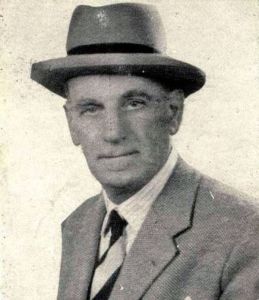Dialectalist writer and poet
Vincenzo Jacono was born in Ospedaletti on 5th September 1887 from Emanuele, originally from Ragusa, and Maria Maddalena Bertolotto, from Bugnato, in the province of La Spezia. He moved to Sanremo with his family just a few months after his birth and spent his youth there, adapting himself to humble trades before graduating as an elementary school teacher.
In 1914 he won the title of provincial champion in the cross-country race.
In May 1915 he was called to arms and participated in the war operations at the front for the entire duration of the conflict. Returning from the war, he obtained the teaching qualification and began teaching.
In 1919 he published his first collection of sonnets: "U scioperu di Maìstri", written on the occasion of the abstention from work proclaimed in that year by primary school teachers.
In the twenties he created the funny character of "Bigìn Sciacastrasse", the protagonist of a successful column in the vernacular of «Eco della Riviera», as opposed to "Mastr'Antò u Basté" by Gin De Stefani; with the latter he also collaborated later on the writing of the comedy "U Ciaravüju", which would have inspired the cartoonist Antonio Rubino one of his most famous watercolours.
In 1922 he published the libretto "A scöra libera pipista", concerning the papal decree on compulsory education, which was followed by other comedies: "U pestùn de Bigìn", "Bigìn a un lavadù" and a magazine "A rexentàmu i drapi", which represent successful satires in dialect with a moral and didactic ending.
In 1927 he married Elvira Cassini, with whom he had two children: Maniele, a talented doctor who died prematurely, and Enza.
Later he made a sketch for a single scene entitled "Che remes-ciu", and in 1960 he published "A storia de Sanremu diita da Bacì Süssatapi", composed of 110 sonnets, with a suggestive cover designed by his daughter-in-law Mirella Nera Perego; later he printed "Terra Nostra Intemelia", which illustrates in fifty-two poems the villages of Western Liguria, the "Nümerate Spiaretéire" and the poem in three "Matüssia" songs.
He also composed four songs in the vernacular: "L'aria de Sanremu", with music by maestro Pippo Barzizza, "Amù variante", with music by maestro Carlo Farina, and finally "Munte Bignun" and "A sciura d'a Parà" with music by engineer Mario Marelli.
His last publication was "Sanremu du méi temp", published by Famija Sanremasca in 1966.
For his vast production as a dialectal author, the town administration conferred him the title of "Meritorious Citizen" of Sanremo on 13 October 1965 with the following motivation: « Writer and vernacular poet, he has given a lively and wide diffusion to the most genuine traditions of our people ».
For his merits in the school and literary field he was also awarded a gold medal by the Ministry of Education.
He died in Ospedaletti on 26 August 1970.
(source Marco Mauro)





